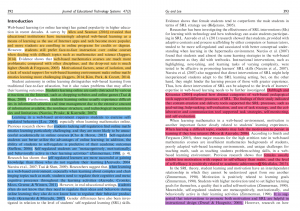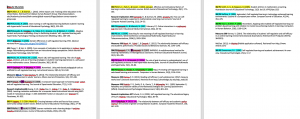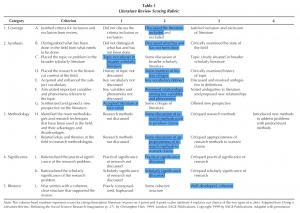
Gif created by ctrades. All photos used in gif taken by
MarcoG2012 and licensed under CC BY 2.0
The pieces are coming together! The massive amounts of information from the readings, the presenters, and our instructors! Exciting! I have had a number of ‘AHA’ moments over the last three days, with over half involving waking up in the middle of the night and making notes on my phone. So today, since it is about getting ready for Wednesday’s class and how information from Wednesday’s class was used, I think a long post is justified.
We were assigned a reading on mixed methods: Assessing the Quality of Mixed Methods Research: Toward a Comprehensive Framework by Alicia O’Cathain, published in 2010. I searched to ensure I had an accurate understanding of mixed methods before reading the academically worded article. This Overview of Mixed Methods from the Center for Innovation in Research and Teaching (CIRT) at the Grand Canyon University in Arizona was concise. Reading through it made me realize that I would have difficulty believing a study that presented only quantitative data since there are always qualitative factors that affect the reliability of the data collected and therefore the validity of the study. Similarly, I would be challenged to accept the findings of a qualitative study that included no quantitative analysis of data. As the article from the CIRT stated: “quantitative research is weak in understanding context or setting . . .(and) qualitative research may include biases and does not lend itself to statistical analysis and generalization.”
Still procrastinating about the assigned reading, I searched for an article in my area to share in class (as required). The top hit was Promoting Students’ Motivation and Use of SRL Strategies in the Web-Based Mathematics Learning Environment by Peidi Gu and Youngjin Lee. It was written in 2017 and published in 2018. I did not save my search and learned my lesson as I have unsuccessfully tried to duplicate the search. Yet the article was EXACTLY what I was looking for and so interesting that I have reread it and analyzed parts of it more than any of the articles I have read so far!
The 4Rs – Researcher
Alicia O’Cathain is currently a professor of Health Services Research at the University of Sheffield, UK. According to Google Scholar, she has her name on 227 articles and has almost 20,000 citations with almost 100 of her articles receiving at least 10 citations within the last 5 years. This is not surprising considering O’Cathain’s first paper was written in 1988. Interestingly, it was Mixed Method Research in Education (on my to-do list to read). Quite a contrast was the primary author of the article I enjoyed so much: Peidi Gu. Gu does not exist on Google Scholar, which worried me. Luckily the biography in the article states she “was a PhD student in Educational Technology in the University of Kansas . . . (w)ith multi-disciplinary background in Computer Science, Mathematics and Education”. Her co-author, Youngjin Lee is an associate professor of Educational Technology with 32 articles listed on Google Scholar with his first article listed in 2000. Upon further research, I found Gu’s dissertation – but saved it for later reading and bibliography mining. So both researchers are credible, not that there was any doubt about a reading supplied for class, but my reading, though engaging, could have been chaff. Valuable lesson: do not waste time reading a found article without researching the author. Fluff is not allowed as a citation resource.
The 4Rs – Research
O’Cathain summarized the difficulties in ascertaining whether mixed methods used in research are legitimate. Her system of nine types of quality assessment in four domains with a number of criteria is rigourous and complicated. But any study conducted with mixed methods should be held to high standards. But is this list really comprehensive? New technology has been created since this article was written.
The research in Gu’s study (and I am going to call it Gu’s study as it is a portion of her Ph.D dissertation which required one of her supervisors’ names to get published) combines qualitative and quantitative methods. Her choice of mixed methods made sense to me as a mathematics educator and is in the area I would like to explore for my project. My understanding of the criteria presented in O’Cathain’s article was furthered by applying it to Gu’s methods, which on a brief consideration, seem reasonable. If I use Gu’s dissertation as a I plan, I will need to assess it more carefully using Cathain’s system.
The 4Rs – Reader (About Me)
O’Cathain’s article was definitely instructional in nature and will be very helpful as a tool. Gu’s article (and later her dissertation) will be extremely useful as I develop what I anticipate my project will be. I am looking at the difficulty motivated international students have coming into our secondary programs at the Grade 10 and 11 level and trying to fit themselves into our mathematics courses. Canada’s integrated mathematics programs do not align well with American programs. Other countries’ programs do not integrate topics in the same years as we do. Our focus on inquiry learning particularly at the Grade 10 level is also very new to most of our students. My hope is to curate as well as create resources that motivated incoming students can explore in order to be more successful in our mathematics programs. Yes, it will be specifically aimed at our school, but hopefully will be adaptable by other math teachers. In addition, I want to include the types of questions found on our British Columbia Education Numeracy Assessment which is now required of students graduating in BC. I believe the cultural basis of some of the questions exclude our international students from success on the assessment (although I have limited data). Although this new assessment should not require preparation, those new to BC or Canadian culture can find some of the situational questions posed are just inaccessible.
Literary Review
The lit review was introduced in class and my head spun. It made sense and yet it didn’t. To me, a lit review sounded like a OPVL (Origin, Purpose, Value, Limitations) form yet it was Chapter 2 of your project? I went home and found a couple of videos that made sense:
So without reading the assigned article, which our instructor previewed in class, I went to Gu’s article to compare her bibliography with her Chapter 2. The colors are not exactly the same, but you can see the relationship between the information presented in the Introduction of the article to the bibliography. There were some citations that were only included in the Measures or Research Implications sections, but the majority are in the area that would become the Chapter 2 of a dissertation or project. Analyzing an article this way made reading David N. Boote and Penny Beile’s Scholars Before Researchers: On the Centrality of the Dissertation Literature Review in Research Preparation much more meaningful.


I did a review of Gu’s article based on Boote and Beile’s rubric. As it is only a 20 page portion of a 146 page dissertation, I thought the level of achievement quite good!

I don’t need convincing that good research is important before undertaking a task, whether it is a thesis or a project. Even in my regular work, I would rather spend a bit of time researching rather than ‘reinventing the wheel’ in case someone else already has a perfectly good ‘wheel’ which I can choose to use or customize. I want to make sure I am using the best of the information that is out there (and free) to create something that is new (or at least new to being free). I feel like one of our Grade 10s, embarking on my International Baccalaureate Middle Years Programme’s Personal Project! Just like our incoming Grade 10 students, I am in the Investigating stage, doing my research and coming up with my problem.
Recent Comments